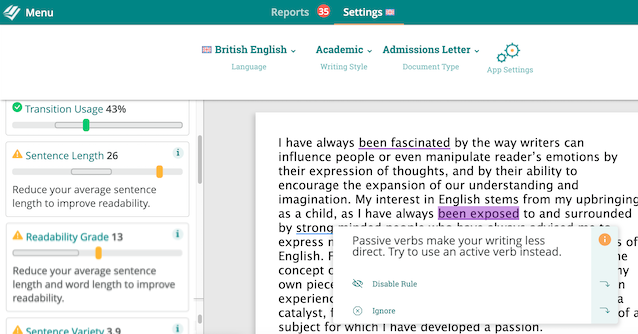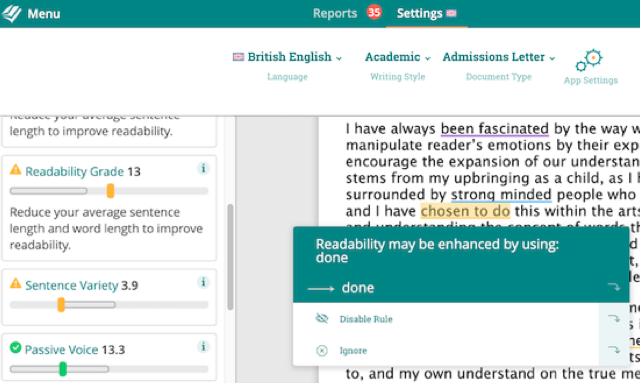
A great admission essay is a simple way to boost your chances of getting accepted to the college you’ve been dreaming about. Colleges typically have far more students apply for courses than they could ever accept. With so many students having a similar list of grades, your admission essay is your chance to explain exactly why you’d be the perfect fit and demonstrate your interest in this particular college.
Also known as a personal statement, admission essays are short, personal essays (up to around 650 words) that give you a chance to show your personality, make a good impression, and write in your unique voice. They also showcase your writing ability to demonstrate you have the skills the college is looking for. Generally, you’ll be given a list of open-ended questions to choose from, giving you the freedom to write about a wide range of topics.
Using ProWritingAid to Draft your College Admission Essay
A great personal statement doesn’t happen overnight. It’s not just correcting typos or grammatical errors, you’ll need to get the structure of your essay right. Expect to write multiple drafts and edit them thoroughly to craft a standout admission essay.
ProWritingAid is far more than a spell checker. It offers you lots of different reports to help you become a better writer. These reports will help you craft a personal statement that stands out for all the right reasons.
There are so many useful reports to choose from, it can feel hard to know where to start. Remember, you don’t need to use each one every time. Here are five tips to help you pick out the best software features for crafting your admission essay.
Tip 1: Getting the Essay Structure Right
The college you’re applying to is reading thousands of personal statements, just like yours. You need to catch their interest from the opening sentence and have a natural flow through to the end. Start by creating a simple outline of your essay. What will each paragraph be about? What will your angle be? Don’t assume that longer is better. Be concise and keep a narrow focus.
Anything can make a good story if you tell it right. Offer an insight into your life and share something meaningful to you. You don’t have to have done something amazing to have a successful essay, everyday life can be just as compelling. The aim of your essay is to reflect on your experiences rather than just recount them. What have you learnt from them?
Make sure your essay answers the question you’ve chosen. Demonstrate your skills and let them see your enthusiasm shine through. Look at great past examples of college essays for inspiration, but don’t be tempted to copy the content; you have your own unique story to tell.
ProWritingAid Reports for Structure
ProWritingAid offers a range of reports that will help you get the structure of your personal essay right. It will help you spot any repetition, sentence structure, and check your transitions are clear between paragraphs. These all make your writing more readable.
Reports to use:
- Transitions: Create signposts that lead your reader through your essay
- Structure: Create varied sentences that start in different ways
- Consistency: Check you’ve used the same spelling and style rules throughout your essay
- Sentence Length: A handy visual of sentence lengths to create interest and variety
Tip 2: Creating a Readable Essay
Once your structure is in place and you’ve written your first draft, start thinking about how you can make your essay as readable as possible. Be honest and let your own voice show through. You want to show rather than tell the college why you’re a great fit.
Poorly worded essays are difficult and frustrating to read. You need to be concise and make each point clearly. Your essay should have flow and allow the reader to concentrate on what you’re saying, not how you say it. Check you don’t contradict yourself or write ambiguously so your meaning is clear.
ProWritingAid Reports for Readability
These reports are useful for creating writing that reads well. You can see how clear your sentences are to understand and eliminate unnecessary "glue" words that slow down the reader.
Reports to use:
- Readability: An overview of how difficult each paragraph is to read
- Sticky sentences: Eliminate unnecessary "glue" words from each sentence
- Clichés: Remove any tired clichés that make your writing predictable and boring
- Acronyms Find any acronyms that may need explaining or removing
The Style Report will also offer readability enhancements, whether it’s changing out a needlessly complex word for a simpler one or removing instances of passive voice.

Passive voice isn’t grammatically incorrect, but it makes your writing less direct. Take the above example. The student writes:
I have always been exposed to and surrounded by strong-minded people.
This sentence makes that student entirely passive. The key question to ask yourself when writing your admissions essay is "So what?" Why does what you are saying make you a good candidate? In that example, the reader will think more about those other strong-minded people than the person applying for the course.
Instead, make yourself the actor in the scene. Let’s try that sentence again:
I have always sought out strong-minded people who encourage me to express myself and challenge my ideas.
Now we know that this candidate is excited by discussion and debate, and that they actively want to learn more.
Tip 3: Choosing the Best Vocabulary
Don’t be tempted to cram your personal statement full of big, complicated word choices. It doesn’t impress anyone. Your essay should sound like you, using your voice rather than a dry academic style. If you aren’t completely sure what a word means, don’t use it, and stick with your usual vocabulary.
Write in varied sentences. That means not always starting them in the same way and avoiding using the same words and phrases as this makes your writing seem repetitive. Keep to the first person as if you are speaking to someone, rather than the third person.
For example:
- Use first person: When I spent the summer volunteering at my local homeless charity, I realised that frustration makes me angry. I channelled that by finding practical ways to make a difference in my community.
- Avoid third person: When Kelly spent the summer volunteering at her local homeless charity, she realised that frustration makes her angry. She channelled that by finding practical ways to make a difference in her community.
ProWritingAid Reports for Vocabulary
ProWritingAid helps you write clear sentences with appropriate vocabulary and varied structure. It makes your writing interesting, easy to read, and free from unnecessary repetition.
Reports to use:
- Diction: Find vague words and poorly constructed sentences
- Thesaurus: Find alternatives to avoid repeating words and phrases
- Repeats: Find words and phrases you keep using in your essay
- Echoes: Find the same words used in close proximity
- Overused Words: Find non-specific, unnecessary words you can remove
Tip 4: Checking In with Goals
However many examples you read, you’re still going to feel unsure that what you’re writing is "right." While there’s no right way to write an admissions letter, it’s reassuring to get some feedback along the way.
ProWritingAid’s Goals feature gives you personalized feedback as you write. Select your document type from the dropdown menu at the top of the screen to tailor your goals to your purpose. If you select "Admissions Letter," the goals you see will be those most relevant to crafting a stand-out letter, like Readability, Sentence Length, Transitions, and Passive Voice:

You’re aiming to get the sliders into the target zones. We’ve generated the target scores from examples of successful admissions letters so that you can feel confident that your writing suits your purpose.
Once you’ve achieved all of the goals for your document, it’s time to move on to your final step: proofreading.
Tip 5: Thorough Proofreading
Even professional writers make spelling and grammar mistakes when they write—lots of them! Proofreading is an essential part of creating an essay that gets you accepted, so don’t rush it. Leave plenty of time for the proofreading process by setting yourself deadlines.
Errors make you look sloppy and give the impression you’re less intelligent and capable than you are. Every mistake creates an instant negative impression. Having a triple-check approach will make sure you’ve found every error. First, check your final draft with ProWritingAid and make any changes, then read it yourself, and finally ask someone else to make a last check before you send.
To proofread effectively, you need a long gap between writing and checking your work. Leave it overnight or at least a few hours so your brain can forget what you’ve written. Change the size and font of the text so it looks unfamiliar and read your work aloud. You’ll be amazed at how many errors you spot.
ProWritingAid Reports for Proofreading
Your college admission essay showcases your writing skills. There’s nothing more off-putting than spelling mistakes and grammatical errors. With advanced software like ProWritingAid, you’ll easily find and correct errors, leaving you with a perfect essay for submission.
Report to use:
- Grammar and Style: A super-charged version of a word processor spell checker
Final Advice
Every college varies widely in what they require you to submit. Check carefully for word limits, topic questions, and whether they need supplementary writing samples (don’t forget to use ProWritingAid for these, too!). Imagine yourself as the admissions officer. Will they remember you? What will make them choose you over others? Avoid reusing your essay for different institutions without personalising it to fit.
ProWritingAid is the essential tool for creating a powerful personal statement. Explore the different reports available and use the Summary Report as an overview to help you identify what you’ve done well and hone your writing skills. With ProWritingAid, you have the software you need to write a personal essay that gets you accepted. Good luck!
Try ProWritingAid’s Editor for Yourself
Paste the opening paragraph of your personal statement into the box below to see how it shapes up.

